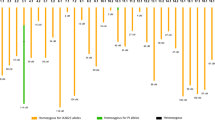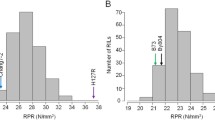Abstract
Key message
Significant introgression-by-environment interactions are observed for traits throughout development from small introgressed segments of the genome.
Abstract
Relatively small genomic introgressions containing quantitative trait loci can have significant impacts on the phenotype of an individual plant. However, the magnitude of phenotypic effects for the same introgression can vary quite substantially in different environments due to introgression-by-environment interactions. To study potential patterns of introgression-by-environment interactions, fifteen near-isogenic lines (NILs) with > 90% B73 genetic background and multiple Mo17 introgressions were grown in 16 different environments. These environments included five geographical locations with multiple planting dates and multiple planting densities. The phenotypic impact of the introgressions was evaluated for up to 26 traits that span different growth stages in each environment to assess introgression-by-environment interactions. Results from this study showed that small portions of the genome can drive significant genotype-by-environment interaction across a wide range of vegetative and reproductive traits, and the magnitude of the introgression-by-environment interaction varies across traits. Some introgressed segments were more prone to introgression-by-environment interaction than others when evaluating the interaction on a whole plant basis throughout developmental time, indicating variation in phenotypic plasticity throughout the genome. Understanding the profile of introgression-by-environment interaction in NILs is useful in consideration of how small introgressions of QTL or transgene containing regions might be expected to impact traits in diverse environments.






Similar content being viewed by others
Change history
20 October 2021
A Correction to this paper has been published: https://doi.org/10.1007/s00122-021-03959-z
References
Allard RW, Bradshaw AD (1964) Implications of genotype-environmental interactions in applied plant breeding. Crop Sci 4:503–508
Balakrishnan D, Subrahmanyam D, Badri J et al (2016) Genotype × environment interactions of yield traits in backcross introgression lines derived from Oryza sativa cv. Swarna/Oryza nivara. Front Plant Sci 7:1530
Bänziger M, Betrán FJ, Lafitte HR (1997) Efficiency of high-nitrogen selection environments for improving maize for low-nitrogen target environments. Crop Sci 37:1103–1109
Bebber DP, Ramotowski MAT, Gurr SJ (2013) Crop pests and pathogens move polewards in a warming world. Nat Clim Chang 3:985–988
Browning BL, Browning SR (2016) Genotype imputation with millions of reference samples. Am J Hum Genet 98:116–126
Chapman SC, Crossa J, Edmeades GO (1997) Genotype by environment effects and selection for drought tolerance in tropical maize. I. Two mode pattern analysis of yield. Euphytica 95:01–09
Crossa J, Fox PN, Pfeiffer WH, Rajaram S, Gauch HG Jr (1991) AMMI adjustment for statistical analysis of an international wheat yield trial. Theor Appl Genet. 81(1):27–37
Crossa J (2012) From genotype × environment interaction to gene × environment interaction. Curr Genom 13:225–244
de Leon N, Jannink J-L, Edwards JW, Kaeppler SM (2016) Introduction to a special issue on genotype by environment interaction. Crop Sci 56:2081–2089
De Mendiburu F, Simon R (2015) Agricolae - Ten years of an open source statistical tool for experiments in breeding, agriculture and biology. PeerJ PrePrints
Deza MM, Deza E (2009) Encyclopedia of distances. In: Deza E, Deza MM (eds) Encyclopedia of distances. Springer, Berlin, pp 1–583
Diniz-Filho JAF, Soares TN, Lima JS et al (2013) Mantel test in population genetics. Genet Mol Biol 36:475–485
Duvick DN (2005a) Genetic progress in yield of United States maize (Zea mays L.). Maydica 50:193
Duvick DN (2005b) The contribution of breeding to yield advances in maize (Zea mays L.). In: Advances in agronomy. Academic Press, pp 83–145
Edwards JW (2016) Genotype× environment interaction for plant density response in maize (Zea mays L.). Crop Sci 56:1493–1505
Eichten SR, Foerster JM, de Leon N et al (2011) B73-Mo17 near-isogenic lines demonstrate dispersed structural variation in maize. Plant Physiol 156:1679–1690
Elias AA, Robbins KR, Doerge RW, Tuinstra MR (2016) Half a century of studying genotype× environment interactions in plant breeding experiments. Crop Sci 56:2090–2105
Elshire RJ, Glaubitz JC, Sun Q et al (2011) A robust, simple genotyping-by-sequencing (GBS) approach for high diversity species. PLoS ONE 6:e19379
El-Soda M, Malosetti M, Zwaan BJ et al (2014) Genotype× environment interaction QTL mapping in plants: lessons from Arabidopsis. Trends Plant Sci 19:390–398
Esuma W, Kawuki RS, Herselman L, Labuschagne MT (2016) Stability and genotype by environment interaction of provitamin A carotenoid and dry matter content in cassava in Uganda. Breed Sci 66(3):434–443
Fan X-M, Kang MS, Chen H et al (2007) Yield stability of maize hybrids evaluated in multi-environment trials in Yunnan, China. Agron J 99:220–228
Finlay KW, Wilkinson GN (1963) The analysis of adaptation in a plant-breeding programme. Aust J Agric Res 14:742–754
Gauch HG (1988) Model selection and validation for yield trials with interaction. Biometrics 44:705–715
Glaubitz JC, Casstevens TM, Lu F et al (2014) TASSEL-GBS: a high capacity genotyping by sequencing analysis pipeline. PLoS ONE. 9(2):e90346
Gonzalo M, Holland JB, Vyn TJ, McIntyre LM (2010) Direct mapping of density response in a population of B73 x Mo17 recombinant inbred lines of maize (Zea Mays L.). Heredity (Edinb) 104(6):583–599
Guo M, Rupe MA, Wei J et al (2014) Maize ARGOS1 (ZAR1) transgenic alleles increase hybrid maize yield. J Exp Bot 65:249–260
Hirsch CN, Foerster JM, Johnson JM et al (2014) Insights into the maize pan-genome and pan-transcriptome. Plant Cell 26:121–135
Holland JB (2007) Genetic architecture of complex traits in plants. Curr Opin Plant Biol 10:156–161
Huang X, Feng Q, Qian Q et al (2009) High-throughput genotyping by whole-genome resequencing. Genome Res 19:1068–1076
Lado B, Barrios PG, Quincke M et al (2016) Modeling genotype× environment interaction for genomic selection with unbalanced data from a wheat breeding program. Crop Sci 56:2165–2179
Li Z, Coffey L, Garfin J et al (2018) Genotype-by-environment interactions affecting heterosis in maize. PLoS ONE 13:e0191321
Lukens LN, Doebley J (1999) Epistatic and environmental interactions for quantitative trait loci involved in maize evolution. Genet Res 74:291–302
Malosetti M, Ribaut J-M, van Eeuwijk FA (2013) The statistical analysis of multi-environment data: modeling genotype-by-environment interaction and its genetic basis. Front Physiol 4:44
Malosetti M, Bustos-Korts D, Boer MP, van Eeuwijk FA (2016) Predicting responses in multiple environments: issues in relation to genotype× environment interactions. Crop Sci 56:2210–2222
Mansfield BD, Mumm RH (2014) Survey of plant density tolerance in U.S Maize Germplasm. Crop Sci 54:157–173
Mantel N (1967) The detection of disease clustering and a generalized regression approach. Cancer Res 27:209–220
Messina C, Hammer G, Dong Z et al (2009) Modelling crop improvement in a G× E× M framework via gene-trait-phenotype relationships. In: Crop physiology: interfacing with genetic improvement and agronomy. Elsevier, The Netherlands, pp 235–265
Miller ND, Haase NJ, Lee J et al (2017) A robust, high-throughput method for computing maize ear, cob, and kernel attributes automatically from images. Plant J 89:169–178
Mohammadi R, Amri A (2016) Genotype x environment interaction implication: a case study of durum wheat breeding in Iran. In: Al-Khayri JM, Jain SM, Johnson DV (eds) Advances in plant breeding strategies: agronomic, abiotic and biotic stress traits. Springer International Publishing, Cham, pp 515–558
Mohammadi R, Farshadfar E, Amri A (2016) Path analysis of genotype× environment interactions in rainfed durum wheat. Plant Prod Sci 19:43–50
Ndhlela T, Herselman L, Magorokosho C et al (2014) Genotype× environment interaction of maize grain yield using AMMI biplots. Crop Sci 54:1992–1999
Nuvunga JJ, Oliveira LA, Pamplona AKA et al (2015) Factor analysis using mixed models of multi-environment trials with different levels of unbalancing. Genet Mol Res 14:14262–14278
Pilloud MA, Hefner JT (2016) Biological distance analysis: forensic and bioarchaeological perspectives. Academic Press, Cambridge
Pordes R, Petravick D, Kramer B et al (2007) The open science grid. In: Journal of Physics: Conference Series. IOP Publishing, p 012057
Ribaut J-M, Hoisington D (1998) Marker-assisted selection: new tools and strategies. Trends Plant Sci 3:236–239
Ribaut J-M, Jiang C, Gonzalez-de-Leon D et al (1997) Identification of quantitative trait loci under drought conditions in tropical maize.2. Yield components and marker-assisted selection strategies. Theor Appl Genet 94:887–896
Thain D, Tannenbaum T, Livny M (2005) Distributed computing in practice: the Condor experience. Concurr Comput 17:323–356
Thiry AA, Chavez Dulanto PN, Reynolds MP, Davies WJ (2016) How can we improve crop genotypes to increase stress resilience and productivity in a future climate? A new crop screening method based on productivity and resistance to abiotic stress. J Exp Bot 67:5593–5603
Trenberth KE, Dai A, van der Schrier G et al (2013) Global warming and changes in drought. Nat Clim Chang 4:17
Tuberosa R (2012) Phenotyping for drought tolerance of crops in the genomics era. Front Physiol 3:347
van Eeuwijk FA (1995) Linear and bilinear models for the analysis of multi-environment trials: I. An inventory of models. Euphytica 84:1–7
Xu Y (2016) Envirotyping for deciphering environmental impacts on crop plants. Theor Appl Genet 129:653–673
Yan W, Cornelius PL, Crossa J, Hunt LA (2001) Two types of GGE biplots for analyzing multi-environment trial data. Crop Sci 41:656–663
Zhao F, Xu S (2012) Genotype by environment interaction of quantitative traits: a case study in barley. G3 Genes Genomes Genetics 2:779–788
Acknowledgements
We thank Jacob Garfin, Peter Hermanson, James Satterlee, Kimberly McFee, and Brad Keiter for technical assistance. This work was supported by the Minnesota Corn Research and Promotion Council (Project Number 4108-16SP), the Minnesota Agricultural Experiment Station (Project 13–113), the Iowa Corn Growers, and Iowa State University’s Plant Sciences Institute.
Author information
Authors and Affiliations
Contributions
CNH, NMS, PSS, SMK, and NdL conceived and designed the experiment. ZL, SBT, LC, NDM, and EPS conducted phenotypic data collection and analysis. ZL, DCK, and AJL performed genotypic data analysis. ZL, NMS, and CNH wrote the manuscript. All authors read and approved the final manuscript.
Corresponding author
Ethics declarations
Conflict of interest
On behalf of all authors, the corresponding author states that there is no conflict of interest.
Additional information
Communicated by Martin Boer.
Publisher's Note
Springer Nature remains neutral with regard to jurisdictional claims in published maps and institutional affiliations.
This article has been corrected to update the ESM file.
Electronic supplementary material
Below is the link to the electronic supplementary material.
Rights and permissions
About this article
Cite this article
Li, Z., Tirado, S.B., Kadam, D.C. et al. Characterizing introgression-by-environment interactions using maize near isogenic lines. Theor Appl Genet 133, 2761–2773 (2020). https://doi.org/10.1007/s00122-020-03630-z
Received:
Accepted:
Published:
Issue Date:
DOI: https://doi.org/10.1007/s00122-020-03630-z




